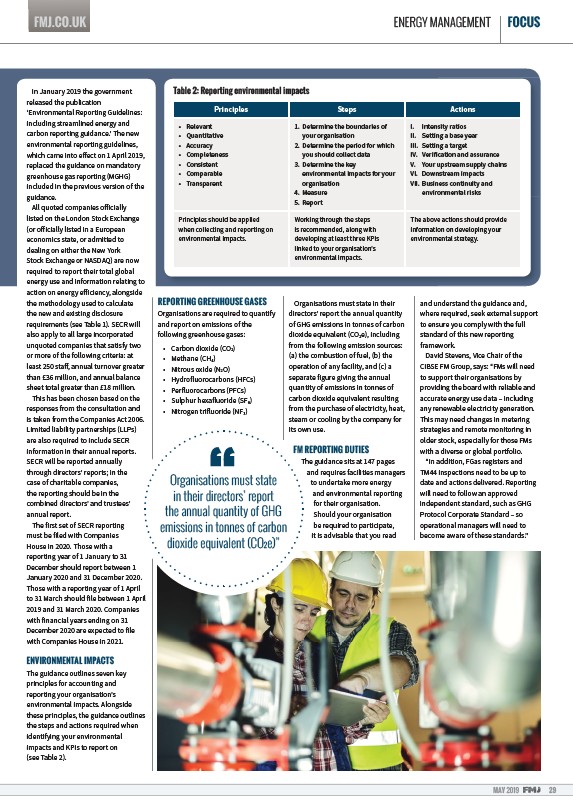
FMJ.CO.UK ENERGY MANAGEMENT FOCUS
MAY 2019 29
In January 2019 the government
released the publication
‘Environmental Reporting Guidelines:
including streamlined energy and
carbon reporting guidance.’ The new
environmental reporting guidelines,
which came into e ect on 1 April 2019,
replaced the guidance on mandatory
greenhouse gas reporting (MGHG)
included in the previous version of the
guidance.
All quoted companies o icially
listed on the London Stock Exchange
(or o icially listed in a European
economics state, or admitted to
dealing on either the New York
Stock Exchange or NASDAQ) are now
required to report their total global
energy use and information relating to
action on energy e iciency, alongside
the methodology used to calculate
the new and existing disclosure
requirements (see Table 1). SECR will
also apply to all large incorporated
unquoted companies that satisfy two
or more of the following criteria: at
least 250 sta , annual turnover greater
than £36 million, and annual balance
sheet total greater than £18 million.
This has been chosen based on the
responses from the consultation and
is taken from the Companies Act 2006.
Limited liability partnerships (LLPs)
are also required to include SECR
information in their annual reports.
SECR will be reported annually
through directors’ reports; in the
case of charitable companies,
the reporting should be in the
combined directors’ and trustees’
annual report.
The first set of SECR reporting
must be filed with Companies
House in 2020. Those with a
reporting year of 1 January to 31
December should report between 1
January 2020 and 31 December 2020.
Those with a reporting year of 1 April
to 31 March should file between 1 April
2019 and 31 March 2020. Companies
with financial years ending on 31
December 2020 are expected to file
with Companies House in 2021.
ENVIRONMENTAL IMPACTS
The guidance outlines seven key
principles for accounting and
reporting your organisation’s
environmental impacts. Alongside
these principles, the guidance outlines
the steps and actions required when
identifying your environmental
impacts and KPIs to report on
(see Table 2).
REPORTING GREENHOUSE GASES
Organisations are required to quantify
and report on emissions of the
following greenhouse gases:
• Carbon dioxide (CO2)
• Methane (CH4)
• Nitrous oxide (N2O)
• Hydrofluorocarbons (HFCs)
• Perfluorocarbons (PFCs)
• Sulphur hexafluoride (SF6)
• Nitrogen trifluoride (NF3)
Organisations must state in their
directors’ report the annual quantity
of GHG emissions in tonnes of carbon
dioxide equivalent (CO2e), including
from the following emission sources:
(a) the combustion of fuel, (b) the
operation of any facility, and (c) a
separate figure giving the annual
quantity of emissions in tonnes of
carbon dioxide equivalent resulting
from the purchase of electricity, heat,
steam or cooling by the company for
its own use.
FM REPORTING DUTIES
The guidance sits at 147 pages
and requires facilities managers
to undertake more energy
and environmental reporting
for their organisation.
Should your organisation
be required to participate,
it is advisable that you read
and understand the guidance and,
where required, seek external support
to ensure you comply with the full
standard of this new reporting
framework.
David Stevens, Vice Chair of the
CIBSE FM Group, says: “FMs will need
to support their organisations by
providing the board with reliable and
accurate energy use data – including
any renewable electricity generation.
This may need changes in metering
strategies and remote monitoring in
older stock, especially for those FMs
with a diverse or global portfolio.
“In addition, FGas registers and
TM44 inspections need to be up to
date and actions delivered. Reporting
will need to follow an approved
independent standard, such as GHG
Protocol Corporate Standard – so
operational managers will need to
become aware of these standards.”
Table 2: Reporting environmental impacts
Principles Steps Actions
• Relevant
• Quantitative
• Accuracy
• Completeness
• Consistent
• Comparable
• Transparent
1. Determine the boundaries of
your organisation
2. Determine the period for which
you should collect data
3. Determine the key
environmental impacts for your
organisation
4. Measure
5. Report
I. Intensity ratios
II. Setting a base year
III. Setting a target
IV. Verification and assurance
V. Your upstream supply chains
VI. Downstream impacts
VII. Business continuity and
environmental risks
Principles should be applied
when collecting and reporting on
environmental impacts.
Working through the steps
is recommended, along with
developing at least three KPIs
linked to your organisation’s
environmental impacts.
The above actions should provide
information on developing your
environmental strategy.
Organisations must state
in their directors’ report
the annual quantity of GHG
emissions in tonnes of carbon
dioxide equivalent (CO2e)”